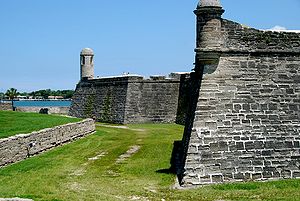Siege of St. Augustine
| Siege of St. Augustine | |||||||
|---|---|---|---|---|---|---|---|
 Castillo de San Marcos |
|||||||
|
|||||||
| Belligerents | |||||||
|
|
|
||||||
| Commanders and leaders | |||||||
|
General James Oglethorpe Ahaya the Cowkeeper Commodore Pearce |
Governor Manuel de Montiano | ||||||
| Strength | |||||||
|
Land forces: Oglethorpe's Regiment, Georgia Provincials, South Carolina Provincials, in all 1,000 infantry, 900 sailors, 1,200 warriors 56 artillery pieces Sea forces: 5 frigates, 3 sloops |
Land forces: 750 infantry, 50 artillery pieces, 1 fort Sea forces : 6 small sail |
||||||
| Casualties and losses | |||||||
| 122 dead, 16 prisoners, 14 deserters, 56 artillery pieces captured, 1 schooner captured |
unknown | ||||||
The Siege of St. Augustine was a military engagement that took place during June–July 1740. It was a part of the much larger conflict known as the War of Jenkins' Ear, between Great Britain and Spain.
After some mutual minor skirmishes, Governor James Oglethorpe of the colony of Georgia raised a mixed force of British regulars (the 42nd Regiment of Foot), colonial militia from the Province of Georgia and the Carolinas, and Native American Creek and Chickasaw, or Uchees. The campaign began in December 1739, and by January Oglethorpe was raiding Spanish forts west of St. Augustine. In May 1740, Oglethorpe undertook an expedition to capture St. Augustine itself. In support of that objective, Oglethorpe first captured Fort San Diego, Fort Picolotta and Fort Mose, the first free black settlement in America.
Oglethorpe deployed his batteries on the island of Santa Anastasia while a British naval squadron blockaded the port. On June 24, Oglethorpe began a 27-day bombardment. On June 26, a sortie by 300 Spanish and free blacks attacked Fort Mose held by 120 Highlander Rangers and 30 Indians. In the Siege of Fort Mose, the garrison was taken by surprise with 68 killed and 34 captured while the Spanish loss was 10 killed.
The Spanish managed to send supply ships through the Royal Navy blockade and any hope of starving St. Augustine into capitulation was lost. Oglethorpe now planned to storm the fortress by land while the navy ships attacked the Spanish ships and half-galleys in the harbor. Commodore Pearce, however resolved to forgo the attack during hurricane season. Oglethorpe gave up the siege and returned to Georgia; abandoning his artillery during his withdrawal.
...
Wikipedia
